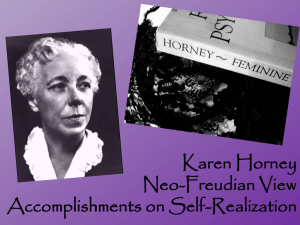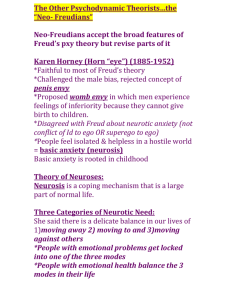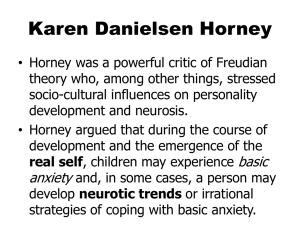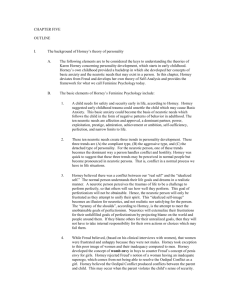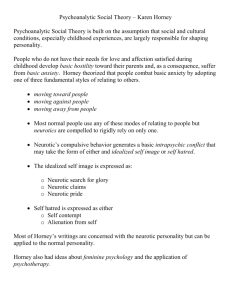KAREN HORNEY Dr. C. George Boeree
advertisement
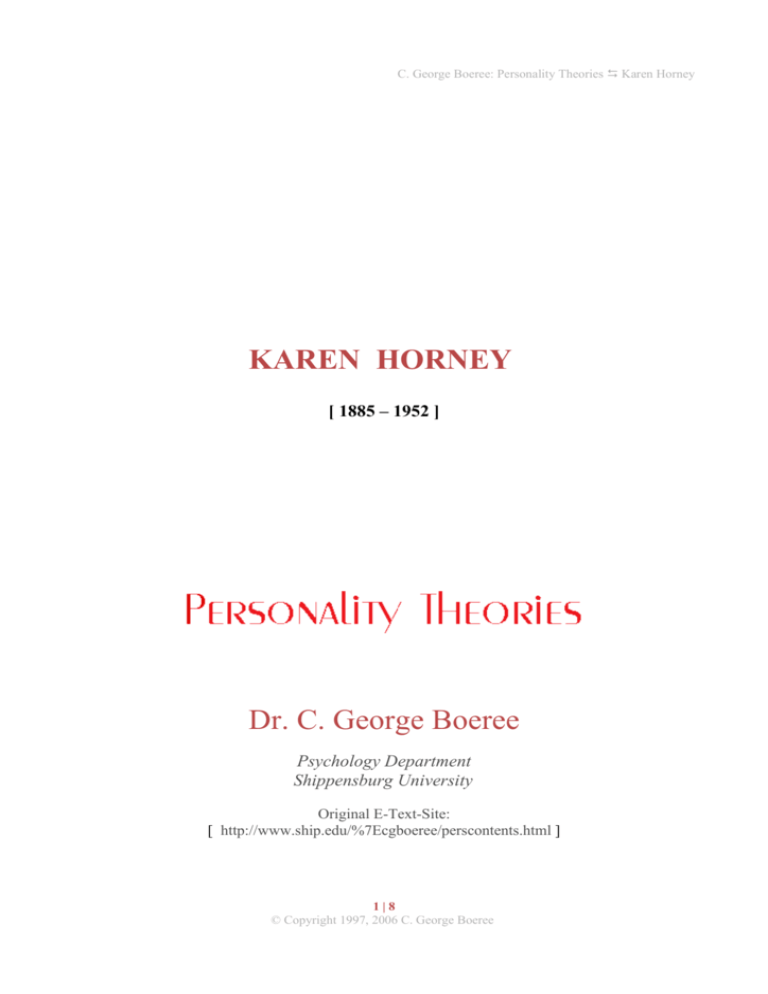
C. George Boeree: Personality Theories Karen Horney KAREN HORNEY [ 1885 – 1952 ] Dr. C. George Boeree Psychology Department Shippensburg University Original E-Text-Site: [ http://www.ship.edu/%7Ecgboeree/perscontents.html ] 1|8 © Copyright 1997, 2006 C. George Boeree C. George Boeree: Personality Theories Karen Horney Index Index 2 Biography 3 Theory 4 Development 5 Self theory 6 Discussion 7 References 8 2|8 © Copyright 1997, 2006 C. George Boeree C. George Boeree: Personality Theories Karen Horney Biography Karen Horney was born September 16, 1885, to Clotilde and Berndt Wackels Danielson. Her father was a ship's captain, a religious man, and an authoritarian. His children called him "the Bible thrower," because, according to Horney, he did! Her mother, who was known as Sonni, was a very different person – Berndt's second wife, 19 years his junior, and considerably more urbane. Karen also had an older brother, also named Berndt, for whom she cared deeply, as well as four older siblings from her father's previous marriage. Karen Horney's childhood seems to have been one of misperceptions: For example, while she paints a picture of her father as a harsh disciplinarian who preferred her brother Berndt over her, he apparently brought her gifts from all over the world and even took her on three long sea voyages with him – a very unusual thing for sea captains to do in those days! Nevertheless, she felt deprived of her father's affections, and so became especially attached to her mother, becoming, as she put it, "her little lamb." At the age of nine, she changed her approach to life, and became ambitious and even rebellious. She said "If I couldn't be pretty, I decided I would be smart," which is only unusual in that she actually was pretty! Also during this time, she developed something of a crush on her own brother. Embarrassed by her attentions, as you might expect of a young teenage boy, he pushed her away. This led to her first bout with depression – a problem that would plague her the rest of her life. In early adulthood came several years of stress. In 1904, her mother divorced her father and left him with Karen and young Berndt. In 1906, she entered medical school, against her parents' wishes and, in fact, against the opinions of polite society of the time. While there, she met a law student named Oscar Horney, whom she married in 1909. In 1910, Karen gave birth to Brigitte, the first of her three daughters. In 1911, her mother Sonni died. The strain of these events were hard on Karen, and she entered psychoanalysis. As Freud might have predicted, she had married a man not unlike her father: Oscar was an authoritarian as harsh with his children as the captain had been with his. Horney notes that she did not intervene, but rather considered the atmosphere good for her children and encouraging their independence. Only many years later did hindsight change her perspective on childrearing. In 1923, Oskar's business collapsed and he developed meningitis. He became a broken man, morose and argumentative. Also in 1923, Karen's brother died at the age of 40 of a pulmonary infection. Karen became very depressed, to the point of swimming out to a sea piling during a vacation with thoughts of committing suicide. Karen and her daughters moved out of Oskar's house in 1926 and, four years later, moved to the U.S., eventually settling in Brooklyn. It may seem odd today, but in the 1930's, Brooklyn was the intellectual capital of the world, due most importantly to the influx of Jewish refugees from Germany. it was here that she became friends with such intellectuals as Erich Fromm and Harry Stack Sullivan, even pausing to have an affair with the former. And it was here that she developed her theories on neurosis, based on her experiences as a psychotherapist. She practiced, taught, and wrote until her death in 1952. 3|8 © Copyright 1997, 2006 C. George Boeree C. George Boeree: Personality Theories Karen Horney Theory Horney's theory is perhaps the best theory of neurosis we have. First, she offered a different way of viewing neurosis. She saw it as much more continuous with normal life than previous theorists. Specifically, she saw neurosis as an attempt to make life bearable, as a way of "interpersonal control and coping." This is, of course, what we all strive to do on a day-to-day basis, only most of us seem to be doing alright, while the neurotic seems to be sinking fast. In her clinical experience, she discerned ten particular patterns of neurotic needs. They are based on things that we all need, but they have become distorted in several ways by the difficulties of some people's lives: Let's take the first need, for affection and approval, as an example. We all need affection, so what makes such a need neurotic? First, the need is unrealistic, unreasonable, indiscriminate. For example, we all need affection, but we don't expect it from everyone we meet. We don't expect great outpourings of affection from even our close friends and relations. We don't expect our loved ones to show affection at all times, in all circumstances. We don't expect great shows of love while our partners are filing out tax forms, for example. And, we realize that there may be times in our lives where we have to be self-sufficient. Second, the neurotic's need is much more intense, and he or she will experience great anxiety if the need is not met, or if it even appears that it may not be met in the future. It is this, of course, that leads to the unrealistic nature of the need. Affection, to continue the example, has to be shown clearly at all times, in all circumstances, by all people, or the panic sets in. The neurotic has made the need too central to their existence. The neurotic needs are as follows: 1. The neurotic need for affection and approval, the indiscriminate need to please others and be liked by them. 2. The neurotic need for a partner, for someone who will take over one's life. This includes the idea that love will solve all of one's problems. Again, we all would like a partner to share life with, but the neurotic goes a step or two too far. 3. The neurotic need to restrict one's life to narrow borders, to be undemanding, satisfied with little, to be inconspicuous. Even this has its normal counterpart. Who hasn't felt the need to simplify life when it gets too stressful, to join a monastic order, disappear into routine, or to return to the womb? 4. The neurotic need for power, for control over others, for a facade of omnipotence. We all seek strength, but the neurotic may be desperate for it. This is dominance for its own sake, often accompanied by a contempt for the weak and a strong belief in one's own rational powers. 5. The neurotic need to exploit others and get the better of them. In the ordinary person, this might be the need to have an effect, to have impact, to be heard. In the neurotic, it can become manipulation and the belief that people are there to be used. It may also involve a fear of being used, of looking stupid. You may have noticed that the people who love practical jokes more often than not cannot take being the butt of such a joke themselves! 6. The neurotic need for social recognition or prestige. We are social creatures, and sexual ones, and like to be appreciated. But these people are overwhelmingly concerned with appearances and popularity. They fear being ignored, be thought plain, "uncool," or "out of it." 7. The neurotic need for personal admiration. We need to be admired for inner qualities as well as outer ones. We need to feel important and valued. But some people are more desperate, and need to remind everyone of their importance – "Nobody recognizes genius," "I'm the real power behind the scenes, you know," and so on. Their fear is of being thought nobodies, unimportant and meaningless. 4|8 © Copyright 1997, 2006 C. George Boeree C. George Boeree: Personality Theories Karen Horney 8. The neurotic need for personal achievement. Again, there is nothing intrinsically wrong with achievement – far from it! But some people are obsessed with it. They have to be number one at everything they do. Since this is, of course, quite a difficult task, you will find these people devaluing anything they cannot be number one in! If they are good runners, then the discus and the hammer are "side shows." If academic abilities are their strength, physical abilities are of no importance, and so on. 9. The neurotic need for self-sufficiency and independence. We should all cultivate some autonomy, but some people feel that they shouldn't ever need anybody. They tend to refuse help and are often reluctant to commit to a relationship. 10. The neurotic need for perfection and unassailability. To become better and better at life and our special interests is hardly neurotic, but some people are driven to be perfect and scared of being flawed. They can't be caught making a mistake and need to be in control at all times. As Horney investigated these neurotic needs, she began to recognize that they can be clustered into three broad coping strategies: I. Compliance, which includes needs one, two, and three. II. Aggression, including needs four through eight. III. Withdrawal, including needs nine, ten, and three. She added three here because it is crucial to the illusion of total independence and perfection that you limit the breadth of your life! In her writings, she used a number of other phrases to refer to these three strategies. Besides compliance, she referred to the first as the moving-toward strategy and the self-effacing solution. One should also note that it is the same as Adler's getting or leaning approach, or the phlegmatic personality. Besides aggression, the second was referred to as moving-against and the expansive solution. It is the same as Alder's ruling or dominant type, or the choleric personality. And, besides withdrawal, she called the third moving-away-from and the resigning solution. It is somewhat like Adler's avoiding type, the melancholy personality. Development It is true that some people who are abused or neglected as children suffer from neuroses as adults. What we often forget is that most do not. If you have a violent father, or a schizophrenic mother, or are sexually molested by a strange uncle, you may nevertheless have other family members that love you, take care of you, and work to protect you from further injury, and you will grow up to be a healthy, happy adult. It is even more true that the great majority of adult neurotics did not in fact suffer from childhood neglect or abuse! So the question becomes, if it is not neglect or abuse that causes neurosis, what does? Horney's answer, which she called the "basic evil," is parental indifference, a lack of warmth and affection in childhood. Even occasional beatings or an early sexual experience can be overcome, if the child feels wanted and loved. The key to understanding parental indifference is that it is a matter of the child's perception, and not the parents' intentions. "The road to hell," it might pay to remember, "is paved with good intentions." A wellintentioned parent may easily communicate indifference to children with such things as showing a preference for one child over another, blaming a child for what they may not have done, overindulging one moment and 5|8 © Copyright 1997, 2006 C. George Boeree C. George Boeree: Personality Theories Karen Horney rejecting another, neglecting to fulfill promises, disturbing a child's friendships, making fun of a child's thinking, and so on. Please notice that many parents – even good ones – find themselves doing these things because of the many pressures they may be under. Other parents do these things because they themselves are neurotic, and place their own needs ahead of their children's Horney noticed that, in contrast to our stereotypes of children as weak and passive, their first reaction to parental indifference is anger, a response she calls basic hostility. To be frustrated first leads to an effort at protesting the injustice! Some children find this hostility effective, and over time it becomes a habitual response to life's difficulties. In other words, they develop an aggressive coping strategy. They say to themselves, "If I have power, no one can hurt me." Most children, however, find themselves overwhelmed by basic anxiety, which in children is mostly a matter of fear of helplessness and abandonment. For survival's sake, basic hostility must be suppressed and the parents won over. If this seems to work better for the child, it may become the preferred coping strategy – compliance. They say to themselves, "If I can make you love me, you will not hurt me." Some children find that neither aggression nor compliance eliminate the perceived parental indifference. They "solve" the problem by withdrawing from family involvement into themselves, eventually becoming sufficient unto themselves – the third coping strategy. They say, "If I withdraw, nothing can hurt me." Self theory Horney had one more way of looking at neurosis – in terms of self images. For Horney, the self is the core of your being, your potential. If you were healthy, you would have an accurate conception of who you are, and you would then be free to realize that potential (self-realization). The neurotic has a different view of things. The neurotics self is "split" into a despised self and an ideal self. Other theorists postulate a "looking-glass" self, the you you think others see. If you look around and see (accurately or not) others despising you, then you take that inside you as what you assume is the real you. On the other hand, if you are lacking in some way, that implies there are certain ideals you should be living up to. You create an ideal self out of these "shoulds." Understand that the ideal self is not a positive goal; it is unrealistic and ultimately impossible. So the neurotic swings back and forth between hating themselves and pretending to be perfect. Horney described this stretching between the despised and ideal selves as "the tyranny of the shoulds" and neurotic "striving for glory:" The compliant person believes "I should be sweet, self-sacrificing, saintly." The aggressive person says "I should be powerful, recognized, a winner." The withdrawing person believes "I should be independent, aloof, perfect." And while vacillating between these two impossible selves, the neurotic is alienated from their true core and prevented from actualizing their potentials. 6|8 © Copyright 1997, 2006 C. George Boeree C. George Boeree: Personality Theories Karen Horney Discussion At first glance, it may appear that Horney stole some of Adler's best ideas. It is clear, for example, that her three coping strategies are very close to Adler's three types. It is, of course, quite conceivable that she was influenced by Adler. But if you look at how she derived her three strategies – by collapsing groups of neurotic needs – you see that she simply came to the same conclusions from a different approach. There is no question, of course, that Adler and Horney (and Fromm and Sullivan) form an unofficial school of psychiatry. They are often called neo-Freudians, although that is rather inaccurate. Unfortunately, the other common term is the Social Psychologists which, while accurate, is a term already used for an area of study. Please notice how Horney's self theory fleshes out Adler's theory about the differences between healthy and neurotic striving for perfection, and (to get ahead of ourselves a bit) how similar this conception is to Carl Rogers'. I usually feel that, when different people come up with similar ideas relatively independently, this is a good sign we're getting at something valuable! Karen Horney had a couple more interesting ideas that should be mentioned. First, she criticized Freud's idea of penis envy. Although she conceded that it did occasionally occur in neurotic women, she felt strongly that it was not anywhere near to a universal. She suggested that what may appear to be signs of penis envy is really justified envy of men's power in this world. In fact, she suggested, there may also be a male counterpart to penis envy – womb envy – in some men who feel envious of a woman's ability to bear children. Perhaps the degree to which many men are driven to succeed, and to have their names live on after them, is in compensation for their inability to more directly extend themselves into the future by means of carrying, bearing, and nurturing their children! A second idea, one that still gets little respect in the psychological community, is self-analysis. Horney wrote one of the earliest "self-help" books, and suggested that, with relatively minor neurotic problems, we could be our own psychiatrists. You can see how this might threaten a few of the delicate egos who make their livings as therapists! I am always surprised at the negative reaction some of my colleagues have to people like Joyce Brothers, the famous psychologist-columnist. Apparently, if you aren't working within the official guidelines, your work is dismissed as "pop psych." The major negative comment I might make about Horney is that her theory is limited to the neurotic. Besides leaving out psychotics and other problems, she leaves out the truly healthy person. Nevertheless, since she does put neurosis and health on a single continuum, she does speak to the neurotic in all of us. 7|8 © Copyright 1997, 2006 C. George Boeree C. George Boeree: Personality Theories Karen Horney References Karen Horney's best book is Neurosis and Human Growth (1950). It is the best book on neurosis ever, in my humble opinion. She wrote more "pop" versions called The Neurotic Personality of our Time (1937) and Our Inner Conflicts (1945). Her thoughts on therapy can be found in New Ways in Psychoanalysis (1939). For an early insight into feminist psychology, read Feminine Psychology (1967). And to read about self-analysis read Self-Analysis (1942). 8|8 © Copyright 1997, 2006 C. George Boeree

